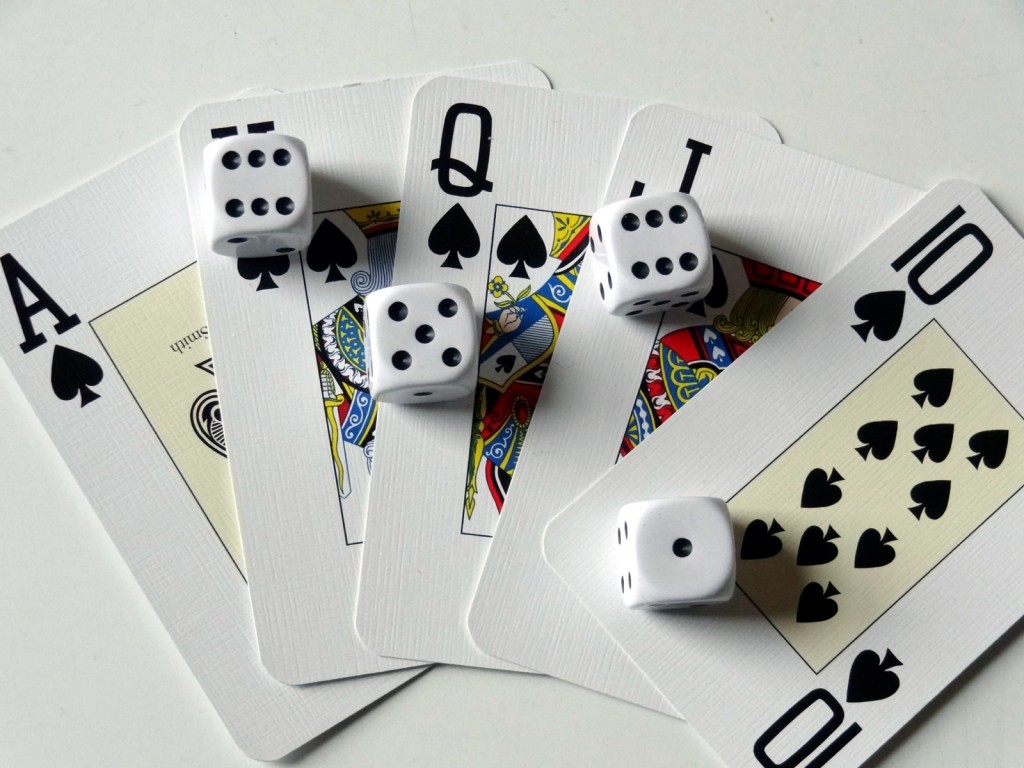 A professor in the USA recently posed an interesting dilemma to students taking his psychology exam. At the end of the exam students were provided with a bonus question in order to gain extra credit. All they had to do was decided whether they would like two or six additional marks adding on to their final score. The twist was that if more than 10% of the class opted for an additional six marks then everyone would get nothing added on!
A professor in the USA recently posed an interesting dilemma to students taking his psychology exam. At the end of the exam students were provided with a bonus question in order to gain extra credit. All they had to do was decided whether they would like two or six additional marks adding on to their final score. The twist was that if more than 10% of the class opted for an additional six marks then everyone would get nothing added on!
The professor had placed the students in a prisoner’s dilemma scenario. To see this consider an individual student weighing up which option to choose; if more than 90% of the class chose two additional marks, then this student is better off choosing six additional marks. Whereas if more than 90% of the class chose six additional marks, then this student is indifferent between the two options (the student will get no additional marks regardless of their choice). It follows that choosing six additional marks is a weakly dominant strategy.
In a similar fashion, in the classic prisoners setting keeping quiet is collectively better, however, each criminal has a strong individual incentive to confess. Likewise, in oligopoly markets the interdependence between firms results in a tension between cooperation and competition. Firms collectively benefit from keeping prices high, but an individual firm has an incentive to undercut its rivals and steal a large share of the market. A strong prediction when self-interested participants play the prisoner’s dilemma game just once and choose their strategies independently is therefore that the prisoners will confess to the crime and that firms will set low prices.
So did the US professor end up giving away many bonus marks? No, about 20% of the class opted for six additional marks and as a result all the students ended up with no extra marks. In fact, the professor claims to have been running the same experiment for the previous seven years and only once has he ended up giving away any bonus marks. On the one hand, this result is consistent with what is predicted in the prisoner’s dilemma game. However, running contrary to this is the fact that around 80% of the students opted for just two additional marks. It would certainly be interesting to see what would happen if in future years the professor relaxed the threshold above which all students get no extra marks.
UMD ‘tragedy of the commons’ tweet goes viral The Baltimore Sun, Quinn Kelley (09/07/15)
A professor tested the ‘Prisoner’s Dilemma’ on his students by bribing them with extra credit points Tech Insider, Will Haskell (17/07/15)
Questions
- Draw the payoff matrix for the student’s dilemma.
- What are some of the possible explanations for around 80% of the class choosing two extra marks?
- How do you think the outcome of the game might have changed if students were allowed to communicate with each other before making their choice on the number of additional marks to ask for?
- How do you think student choices would change if the threshold above which all students get no extra marks was varied?
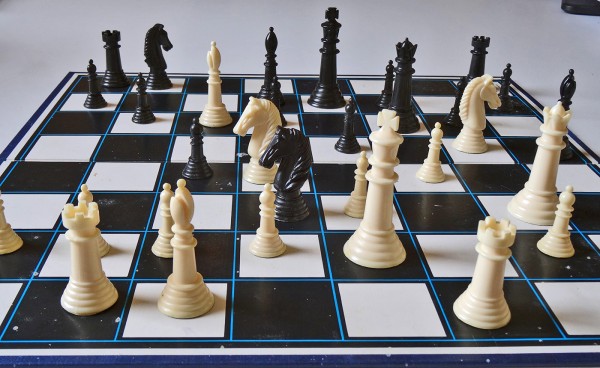
The negotiations between Greece and the ‘troika’ of creditors (the IMF, the European Commission and the ECB) have seen many twists and turns before breaking down on 26 June. Throughout, both sides have sought to give as little as possible while seeking a compromise. Both sides have claimed that their position is reasonable, even though a gulf has remained between them.
What has been playing out is a high-stakes game, where the optimum outcome for each side is quite different.
Greece seeks bailout terms that would allow it to achieve a smaller primary budget surplus (but still a surplus in the midst of a deep recession). The surplus would be achieved largely through tax rises on the wealthy rather than further cuts that would hit the poor hard. It is also seeking a substantial amount of debt forgiveness to make servicing the remaining debt possible.

The troika is seeking a larger budget surplus than the Greeks are willing to contemplate. This, it maintains, should be achieved largely through additional cuts in government expenditure, including further reductions in pensions and in public-sector wages.
Both sides used threats and promises as the negotiations became more and more acrimonious.
The troika threatened to withhold the final €7.2bn of the bailout necessary to pay the €1.6bn due to the IMF on 30 June, unless the Greeks accepted the terms of the austerity package put to them. The Greek Prime Minister, Alexis Tsipras, in rejecting the proposals, called a referendum on the package. This threatens the stability of the eurozone as a No vote, if it led to a Greek exit from the eurozone, could undermine confidence in monetary union. After all, if Greece could be forced out, other countries facing severe difficulties might also be forced out at some point in the future. Once a country leaves the eurozone, the monetary union becomes more like a system of pegged exchange rates. And pegged exchange rates are open to destabilising speculation at times of economic divergence.
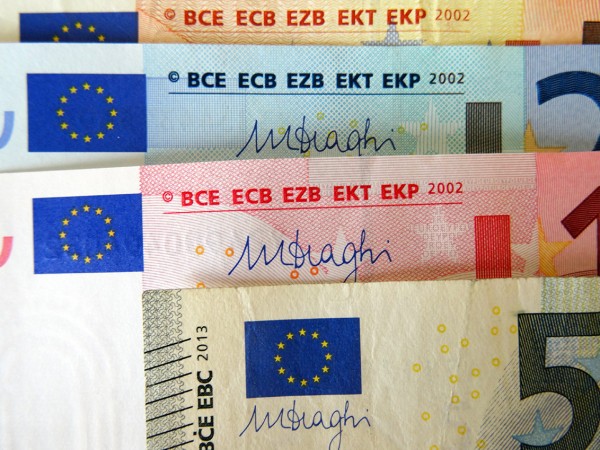 A Greek exit from the euro (dubbed ‘Grexit’) is seen as undesirable by most Greeks and by most politicians in the rest of Europe. The optimum for both sides collectively would be a compromise, which saw more modest cuts by Greece and the eurozone remaining intact. By both sides seeking to maximise their own position, the Nash equilibrium is certainly not the best outcome.
A Greek exit from the euro (dubbed ‘Grexit’) is seen as undesirable by most Greeks and by most politicians in the rest of Europe. The optimum for both sides collectively would be a compromise, which saw more modest cuts by Greece and the eurozone remaining intact. By both sides seeking to maximise their own position, the Nash equilibrium is certainly not the best outcome.
But as long as the troika believes that the Greeks are likely to vote Yes to the proposed bailout terms, it still hopes to get the outcome that is best from its point of view – an outcome that would probably involve regime change. And as long as the Greek government hopes that a No vote will force the troika to think again and come back with less austere proposals, it still hopes to get the outcome that is best from its point of view. But the outcome of this game of ‘chicken’ could well be Grexit and a Nash equilibrium that neither side wants.
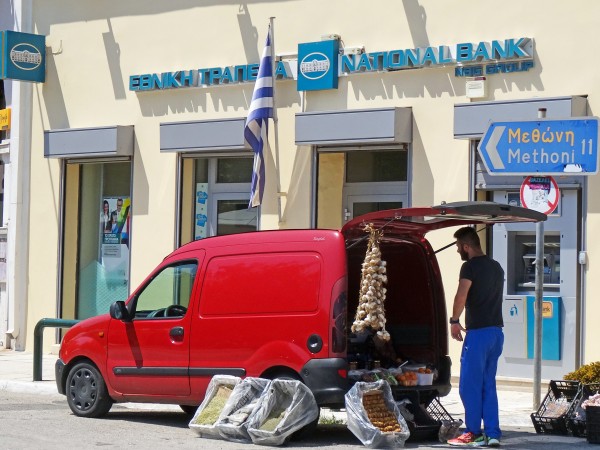 But while the endgame is being played out by politicians, people in Greece are suffering. Policies of severely depressing aggregate demand to turn a large budget deficit into a primary budget surplus have led to the economy shrinking by 26%, overall unemployment of 27% and youth unemployment of over 60%. The Greeks truly believe themselves to be stuck between a rock and a hard place.
But while the endgame is being played out by politicians, people in Greece are suffering. Policies of severely depressing aggregate demand to turn a large budget deficit into a primary budget surplus have led to the economy shrinking by 26%, overall unemployment of 27% and youth unemployment of over 60%. The Greeks truly believe themselves to be stuck between a rock and a hard place.
The following articles look at the nature of the ‘game’ being played and at the effects on the Greek economy, both of the proposed austerity package proposed by the troika and Grexit. They also look at the knock-on effects for the eurozone, the EU and the global economy.
Can game theory explain the Greek debt crisis? BBC News Magazine, Marcus Miller (26/6/15)
Against the Grain: What Yanis Varoufakis can learn from a real game theory master – Nicola Sturgeon City A.M., Paul Ormerod (24/6/15)
John Nash’s Game Theory and Greece Bloomberg, Mohamed A. El-Erian (29/5/15)
The Greek crisis: that 1931 moment The Economist, Buttonwood column (23/6/15)
How game theory explains Grexit and may also predict Greek poll outcome The Conversation, Partha Gangopadhyay (1/7/15)
Greece debt crisis: Tsipras may resign if Greeks vote yes BBC News (30/6/15)
Greek debt crisis: Is Grexit inevitable? BBC News. Paul Kirby (29/6/15)
Existential threat to euro from Greek exit BBC News, Robert Peston (29/6/15)
How I would vote in the Greek referendum The Guardian, Joseph Stiglitz (29/6/15)
Greece in chaos: will Syriza’s last desperate gamble pay off? The Guardian, Paul Mason (29/6/15)
What happens if Greece defaults on its International Monetary Fund loans? The Telegraph, Mehreen Khan (30/6/15)
For Greece’s international creditors, regime change is the ultimate goal The Telegraph, Jeremy Warner (29/6/15)
Europe has suffered a reputational catastrophe in Greece The Telegraph, Ambrose Evans-Pritchard (2/7/15)
Questions
- What is meant by a primary budget surplus?
- What was the troika’s proposal on the table on the 26 June that was rejected by the Greek government?
- What was the Greek government’s proposal that was rejected by the troika?
- Explain the decision trees outlined in the first BBC article below.
- In terms of game theory, what form of game is being played?
- Are the negotiations between the Greek government and the troika a prisoners’ dilemma game? Explain why or why not.
- Does the game being played between the SNP and the Conservative government in the UK offer any useful lessons to both sides in the negotiations over Greece’s possible bailout and its terms?
- Does a No vote in the referendum on 5 July imply that Greece must leave the euro? Explain.
- What would be the effects of further austerity measures on aggregate demand? What benefits to the Greek economy could be achieved from such measures?
- Why may pegged exchange rates be regarded as the worst of both worlds – a single currency in a monetary union and floating exchange rates?
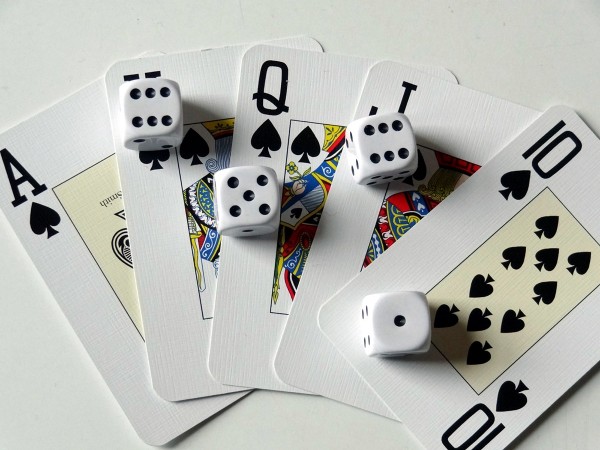 John Nash was one of the pioneers of game theory and in 1994 was awarded the Nobel prize in economics for his work in this field. He was also the subject of the 2001 film, A beautiful mind, where the young John Nash was played by Russell Crowe, for which he won an Oscar.
John Nash was one of the pioneers of game theory and in 1994 was awarded the Nobel prize in economics for his work in this field. He was also the subject of the 2001 film, A beautiful mind, where the young John Nash was played by Russell Crowe, for which he won an Oscar.
Tragically, John Nash and his wife were killed in a car crash on May 23: he was 86 years old. Since his death there have been many tributes paid to him and his work.
As a student of economics you will almost certainly have studied the concept of a Nash equilibrium: a situation where everyone makes their best choice, given the choices of the other ‘players’ in a ‘game’. But a Nash equilibrium is not in the collective best interests of the participants in a non-cooperative game.
This is a very different concept of equilibrium from the simple equilibrium in a perfectly competitive market. In fact, in the complex world of strategic decision making, where firms are constantly looking at their rivals’ behaviour and possible reactions to their own behaviour, there are all sorts of Nash equilibria which are clearly sub-optimal. Competition may be highly destructive.
The following obituaries look at Nash’s contribution to the development of economics. As the Bloomberg article states:
The game theory concepts that Nash’s math[s] brought to the field were a true paradigm shift in economics. Macroeconomists, who continue to use the old Walrasian notion of equilibrium typically engage in hand-waving about how the macroeconomy is too big for strategic interactions to matter. But most of the economics profession has gradually shifted toward Nash equilibrium. The 2014 Nobel winner, Jean Tirole, is emblematic of the new economics. And many of the biggest successes in applied economics, like the auctions that power Google’s advertising, rely on Nash’s technique.
Do we owe him as much as Adam Smith?
Articles
Death of John Nash and His Beautiful Ideas Bloomberg, Noah Smith (26/5/15)
John Nash, economist and mathematician, 1928–2015 Financial Times, Ferdinando Giugliano (25/5/15)
Obituary: John Nash: Lost and found The Economist (28/5/15)
Remembering John Nash: Finding equations to explain the world The Economist (28/5/15)
John F. Nash Jr., Math Genius Defined by a ‘Beautiful Mind,’ Dies at 86 New York Times, Erica Goode (24/5/15)
Explaining a Cornerstone of Game Theory: John Nash’s Equilibrium New York Times, Kenneth Chang (24/5/15)
John Nash’s Indelible Contribution To Economic Analysis Forbes, Jon Hartley (25/5/15)
John Nash’s ground-breaking contributions to maths BBC News, John Moriarty (24/5/15)
From the archives: Nash’s Nobel prize The Economist (24/5/15)
 A beautiful strategy: John Nash’s ‘game theory’ explained Hindustan Times, Gaurav Choudhury (25/5/15)
A beautiful strategy: John Nash’s ‘game theory’ explained Hindustan Times, Gaurav Choudhury (25/5/15)
Interview with John Nash
 Interview with John Nash Nobelprize.org (Sept 2004)
Interview with John Nash Nobelprize.org (Sept 2004)
Questions
- What is meant by the ‘prisoners’ dilemma’? How is this a demonstration of a sub-optimal Nash equilibrium in a non-cooperative game?
- Why is it difficult to predict the outcome of a non-cooperative game?
- Give some examples of non-cooperative games played by companies competing with each other.
- Give some examples of non-cooperative games played by nations competing with each other.
- Why do competition authorities try to prevent cooperation between businesses?
- Why may a cooperative equilibrium between firms be an unstable one?
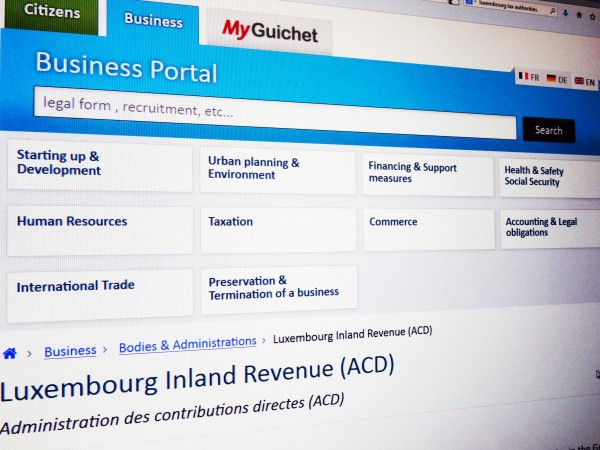 An investigation by the International Consortium of Investigative Journalists has revealed how more than 1000 businesses from 340 major companies from around the world have used Luxembourg as a base for avoiding huge amounts of tax. Many of the companies are household names, such as Ikea, FedEx, Apple, Pepsi, Coca Cola, Dyson, Amazon, Fiat, Google, Accenture, Burberry, Procter & Gamble, Heinz, JP Morgan, Caterpillar, Deutsche Bank and Starbucks. Through complicated systems of ‘advanced tax agreements’ (ATAs), negotiated with the Luxembourg authorities via accountants PricewaterhouseCoopers (PwC), companies have used various methods of avoiding tax.
An investigation by the International Consortium of Investigative Journalists has revealed how more than 1000 businesses from 340 major companies from around the world have used Luxembourg as a base for avoiding huge amounts of tax. Many of the companies are household names, such as Ikea, FedEx, Apple, Pepsi, Coca Cola, Dyson, Amazon, Fiat, Google, Accenture, Burberry, Procter & Gamble, Heinz, JP Morgan, Caterpillar, Deutsche Bank and Starbucks. Through complicated systems of ‘advanced tax agreements’ (ATAs), negotiated with the Luxembourg authorities via accountants PricewaterhouseCoopers (PwC), companies have used various methods of avoiding tax.
Although such measures are legal, they have denied other countries vast amounts of tax revenues on sales generated in their own countries. Instead, the much reduced tax bills have been paid to Luxembourg. The result is that this tiny country, with a population of just 550,000, has, according to the IMF, the highest (nominal) GDP per head in the world (estimated to be $116,752 in 2014).
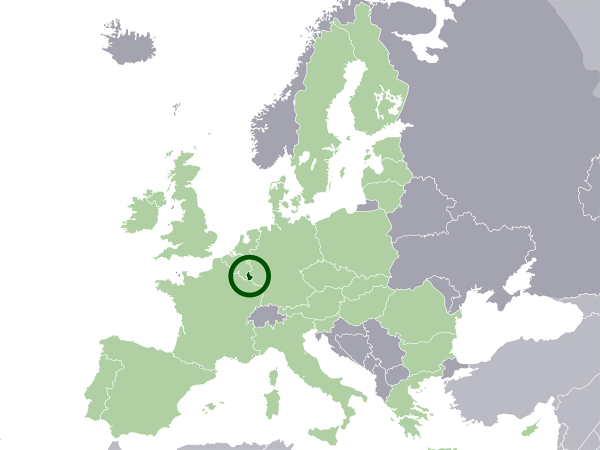 So what methods do Luxembourg and these multinational companies use to reduce the companies’ tax bills? There are three main methods. All involve having a subsidiary based in Luxembourg: often little more than a small office with one employee, a telephone and a bank account. All involve varieties of transfer pricing: setting prices that the company charges itself in transactions between a subsidiary in Luxembourg and divisions in other countrries.
So what methods do Luxembourg and these multinational companies use to reduce the companies’ tax bills? There are three main methods. All involve having a subsidiary based in Luxembourg: often little more than a small office with one employee, a telephone and a bank account. All involve varieties of transfer pricing: setting prices that the company charges itself in transactions between a subsidiary in Luxembourg and divisions in other countrries.
The first method is the use of internal loans. Companies lend money to themselves, say in the UK, from Luxembourg at high interest rates. The loan interest can be offset against profit in the UK, reducing tax liability to the UK tax authorities. But the interest earned by the Luxembourg subsidiary incurs very low taxes. Profits are thus effectively transferred from the UK to Luxembourg and a much lower tax bill is incurred.
The second involves royalty payments for the use of the company’s brands. These are owned by the Luxembourg subsidiary and the overseas divisions pay the Luxembourg subsidiary large sums for using the logos, designs and brand names. Thus, again, profits are transferred to Luxembourg, where there is a generous tax exemption.
The third involves generous allowances in Luxembourg for losses in the value of investments, even without the company having first to sell the investments. These losses can be offset against future profits, again reducing tax liability. By transferring losses made elsewhere to Luxembourg, again usually by some form of transfer pricing, these can be used to reduce the already small tax bill in Luxembourg even further.
 Tax loopholes offered by tax havens, such as Luxembourg, the Cayman Islands and the Channel Islands, are denying exchequers around the world vast sums. Not surprisingly, countries, especially those with large deficits, are concerned to address the issue of tax avoidance by multinationals. This is one item on the agenda of the G20 meeting in Brisbane from the 12 to 16 November 2014.
Tax loopholes offered by tax havens, such as Luxembourg, the Cayman Islands and the Channel Islands, are denying exchequers around the world vast sums. Not surprisingly, countries, especially those with large deficits, are concerned to address the issue of tax avoidance by multinationals. This is one item on the agenda of the G20 meeting in Brisbane from the 12 to 16 November 2014.
The problem, however, is that, with countries seeking to attract multinational investment and to gain tax revenues from them, there is an incentive to reduce corporate tax rates. Getting any binding agreement on tax harmonisation, and creating an essentially global single market, is likely, therefore, to prove virtually impossible.
Webcasts and videos
 Luxembourg Leaks: Tricks of the Trade ICIJ in partnership with the Pulitzer Center (5/11/14)
Luxembourg Leaks: Tricks of the Trade ICIJ in partnership with the Pulitzer Center (5/11/14)
 Luxembourg ‘abetted’ companies in avoiding taxes France 24, Siobhán Silke (6/11/14)
Luxembourg ‘abetted’ companies in avoiding taxes France 24, Siobhán Silke (6/11/14)
 Tax deals with Luxembourg save companies billions, says report Deutsche Welle, Dagmar Zindel (6/11/14)
Tax deals with Luxembourg save companies billions, says report Deutsche Welle, Dagmar Zindel (6/11/14)
 Luxembourg: the tax haven and the $870m loan company above a stamp shop The Guardian, John Domokos, Rupert Neate and Simon Bowers (5/11/14)
Luxembourg: the tax haven and the $870m loan company above a stamp shop The Guardian, John Domokos, Rupert Neate and Simon Bowers (5/11/14)
 Luxembourg leaks: nation under spotlight over tax avoidance claims euronews (6/11/14)
Luxembourg leaks: nation under spotlight over tax avoidance claims euronews (6/11/14)
 Northern and Shell used west Dublin address to cut Luxembourg tax bill on €1bn The Irish Times, Colm Keena (6/11/14)
Northern and Shell used west Dublin address to cut Luxembourg tax bill on €1bn The Irish Times, Colm Keena (6/11/14)
 The ATO’s global tax avoidance investigation ABC News, Phillip Lasker (9/11/14)
The ATO’s global tax avoidance investigation ABC News, Phillip Lasker (9/11/14)
 Pepsi, IKEA Secret Luxembourg Tax Deals Exposed TheLipTV, Elliot Hill (9/11/14)
Pepsi, IKEA Secret Luxembourg Tax Deals Exposed TheLipTV, Elliot Hill (9/11/14)
Articles
Leaked Docs Expose More Than 340 Companies’ Tax Schemes In Luxembourg Huffington Post, Leslie Wayne, Kelly Carr, Marina Walker Guevara, Mar Cabra and Michael Hudson (5/11/14)
Luxembourg tax files: how tiny state rubber-stamped tax avoidance on an industrial scale The Guardian, Simon Bowers (5/11/14)
Fact and fiction blur in tales of tax avoidance The Guardian (9/11/14)
companies engaged in tax avoidance The Guardian, Michael Safi (6/11/14)
The Guardian view on tax avoidance: Europe must take Luxembourg to task The Guardian, Editorial (6/11/14)
G20 leaders in the mood to act on tax avoidance after Luxembourg leaks Sydney Morning Herald, Tom Allard (6/11/14)
Scale of Luxembourg tax avoidance revealed economia, Oliver Griffin (6/11/14)
EU to press Luxembourg over tax breaks amid fresh allegations BBC News (6/11/14)
Luxembourg leaks: G20 alone can’t stamp out tax avoidance The Conversation, Charles Sampford (7/11/14)
‘Lux leaks’ scandal shows why tax avoidance is a bad idea European Voice, Paige Morrow (8/11/14)
EU to Probe Luxembourg’s ‘Sweetheart Tax Deal’ with Amazon International Business Times, Jerin Mathew (7/10/14)
Investigative Project
Luxembourg Leaks: Global Companies’ Secrets Exposed The International Consortium of Investigative Journalists (5/11/14)
Questions
- Distinguish between tax avoidance and tax evasion. Which of the two is being practised by companies in their arrangements with Luxembourg?
- Explain what is meant by transfer pricing.
- Do a search of companies to find out what parts of their operations as based in Luxembourg.
- In what sense can the setting of corporate taxes be seen as a prisoner’s dilemma game between countries?
- Discuss the merits of changing corporate taxes so that they are based on revenues earned in a country rather than on profits.
- What type of agreement on tax havens is likely to be achieved by the international community?
- Is it desirable for companies to be able to offset losses against future profits?
 In an earlier post, Elizabeth looked at oligopolistic competition between supermarkets. Although supermarkets have been accused of tacit price collusion on many occasions in the past, price competition has been growing. And recent developments show that it is likely to get a lot fiercer as the ‘big four’ try to take on the ‘deep discounters’, Aldi and Lidl.
In an earlier post, Elizabeth looked at oligopolistic competition between supermarkets. Although supermarkets have been accused of tacit price collusion on many occasions in the past, price competition has been growing. And recent developments show that it is likely to get a lot fiercer as the ‘big four’ try to take on the ‘deep discounters’, Aldi and Lidl.
Part of the reason for the growth in price competition has been a change in shopping behaviour. Rather than doing one big shop per week in Tesco, Sainsbury’s, Asda or Morrisons, many consumers are doing smaller shops as they seek to get more for their money. A pattern is emerging for many consumers who are getting their essentials in Aldi or Lidl, their ‘special’ items in more upmarket shops, such as Waitrose, Marks & Spencer or small high street shops (such as bakers and ethnic food shops) and getting much fewer products from the big four. Other consumers, on limited incomes, who have seen their real incomes fall as prices have risen faster than wages, are doing virtually all their shopping in the deep discounters. As the Guardian article below states:
A steely focus on price and simplicity, against a backdrop of falling living standards that has sharpened customers’ eye for a bargain, has seen the discounter grab market share from competitors and transform what we expect from our weekly shop.
The result is that the big four are seeing their market share falling, as the chart shows. 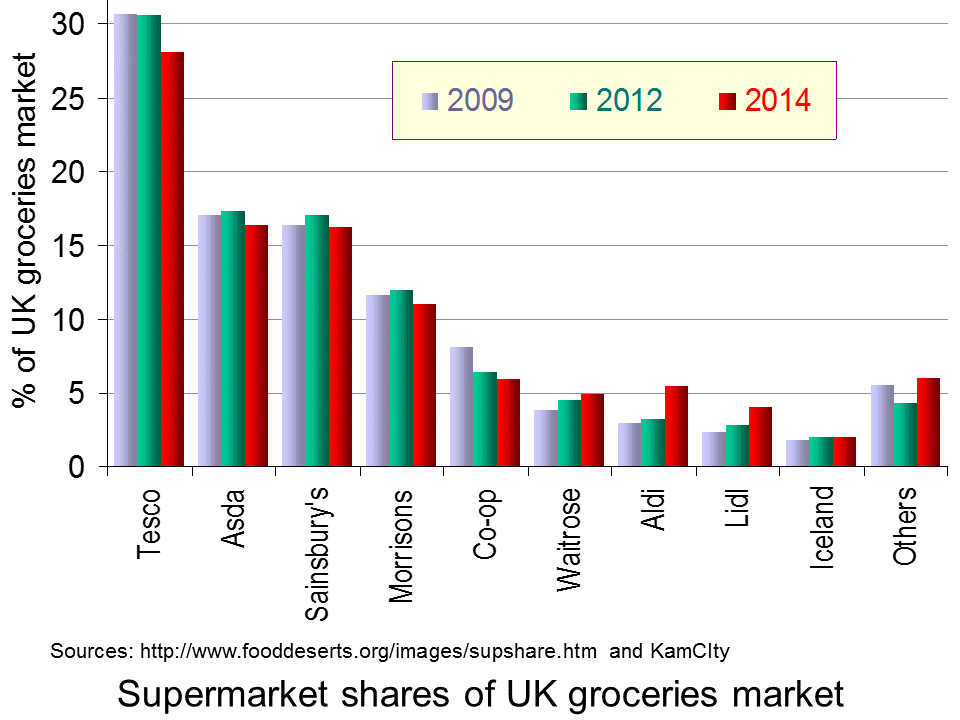 (Click here for a PowerPoint of the chart.) In the past year, Tesco’s market share has fallen from 29.9% to 28.1%, Asda’s from 17.8% to 16.3%, Sainsbury’s from 16.9% to 16.2% and Morrisons’ from 11.7% to 11.0%. By contrast, Aldi’s has risen from 3.9% to 5.4% and Lidl’s from 3.1% to 4.0%, while Waitrose’s has also risen, from 4.7% to 4.9%. And it’s not just market share that has been falling for the big four. Profits have also fallen, as have share prices. Sales revenues in the four weeks to 13 September are down 1.6% on the same period a year ago; sales volumes are down 1.9%.
(Click here for a PowerPoint of the chart.) In the past year, Tesco’s market share has fallen from 29.9% to 28.1%, Asda’s from 17.8% to 16.3%, Sainsbury’s from 16.9% to 16.2% and Morrisons’ from 11.7% to 11.0%. By contrast, Aldi’s has risen from 3.9% to 5.4% and Lidl’s from 3.1% to 4.0%, while Waitrose’s has also risen, from 4.7% to 4.9%. And it’s not just market share that has been falling for the big four. Profits have also fallen, as have share prices. Sales revenues in the four weeks to 13 September are down 1.6% on the same period a year ago; sales volumes are down 1.9%.
But can the big four take on the discounters at their own game? Morrison’s has just announced a form of price match scheme called ‘Match & More’. If a shopper finds that a comparable grocery shop is cheaper in not only Tesco, Sainsbury’s or Asda, but also in Aldi or Lidl, then ‘Match & More users will automatically get the difference back in points on their card. Shoppers also will be able to collect extra points on hundreds of featured products and fuel’. When the difference has risen to a total £5 (5000 points), the shopper will get a £5 voucher at the till. The idea is to encourage customers to stay loyal to Morrisons.
 But what if Tesco, Asda and Sainsbury’s do the same? What will be the impact on their prices and profits. Will there be a race to the bottom in prices, or will they be able to keep prices higher than the deep discounters, hoping that many customers will not cash in their vouchers?
But what if Tesco, Asda and Sainsbury’s do the same? What will be the impact on their prices and profits. Will there be a race to the bottom in prices, or will they be able to keep prices higher than the deep discounters, hoping that many customers will not cash in their vouchers?
But if effectively the big four felt forced to cut their prices to match Aldi and Lidl, could they afford to do so? This depends on their comparative average costs. At first sight, it might be thought that the big four could succeed in profitably matching the discounters, thereby clawing back market share. After all, they are much bigger and it might be thought that they would benefit from greater economies of scale and hence lower costs.
But it is not as simple as this. The discounters have lower costs than the big four. Their shops are typically in areas where rents or land prices are lower; their shops are smaller; they carry many fewer lines and thus gain economies of scale on each line; they have a much higher proportion of own-brand products; products are displayed in the boxes they come in, thus saving on the staff costs of unpacking them and placing them on shelves; they buy what is cheapest and thus do not always display the same brands.
So is Morrison’s a wise strategy? Will other supermarkets be forced to follow? Is there a prisoners’ dilemma here and, if so, is there any form of collusion in which the big four can engage which is not illegal? Can the big four differentiate themselves from the discounters and the up-market supermarkets in ways that will attract back customers?
It is worrying times for the big four.
Articles
- Heavy Discounters Up Pressure On The UK’s Big Four Supermarkets
Alliance News, Rowena Harris-Doughty (3/6/14)
- Tesco loses more market share as supermarket sector slows to record low
CITY A.M., Catherine Neilan (23/9/14)
- Record low for grocery market growth as inflation disappears
Kantar World Panel, Fraser McKevitt (23/9/14)
- How Aldi’s price plan shook up Tesco, Morrison’s, Asda and Sainsbury’s
The Guardian, Sarah Butler (29/9/14)
- Sainsbury’s shares drop 7% on falling sales report
BBC News (1/10/14)
- Sainsbury results: the reaction
Food Manufacture, Mike Stones (3/10/14)
- Morrisons Becomes First Of Big Four Grocers To Price Match Aldi, Lidl
Alliance News, Rowena Harris-Doughty (2/10/14)
- UK: Morrisons Takes On Discounters With Price Match Card
KamCity (3/10/14)
- Morrisons to match the prices of Aldi and Lidl
The Telegraph, Graham Ruddick (2/10/14)
- Three reasons why Morrisons price-matching Aldi and Lidl is not a ‘gamechanger’
The Telegraph, Graham Ruddick (2/10/14)
Questions
- Would it be possible for the big four to price match the deep discounters?
- What is meant by the prisoners’ dilemma? In what ways are the big four in a prisoners’ dilemma situation?
- Assume that you had to advise Tesco on it strategy? What advise would you give it and why?
- Assume that two firms, M and A, are playing the following ‘game’: firm M pledges to match firm A’s prices; and firm A pledges to sell at 2% below M’s price. What will be the outcome of this game?
- Is Morrisons wise to adopt its ‘Match & More’ strategy?
- Why is it difficult for Morrisons to make a like-for-like comparison with Aldi and Lidl in its ‘Match & More’ strategy?
- Why may Aldi and Lidl benefit from Morrisons’ strategy?
 A professor in the USA recently posed an interesting dilemma to students taking his psychology exam. At the end of the exam students were provided with a bonus question in order to gain extra credit. All they had to do was decided whether they would like two or six additional marks adding on to their final score. The twist was that if more than 10% of the class opted for an additional six marks then everyone would get nothing added on!
A professor in the USA recently posed an interesting dilemma to students taking his psychology exam. At the end of the exam students were provided with a bonus question in order to gain extra credit. All they had to do was decided whether they would like two or six additional marks adding on to their final score. The twist was that if more than 10% of the class opted for an additional six marks then everyone would get nothing added on!










